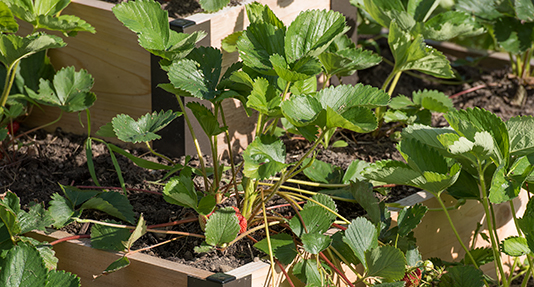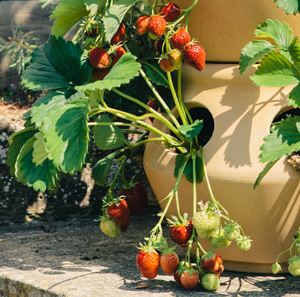Backyard Berries
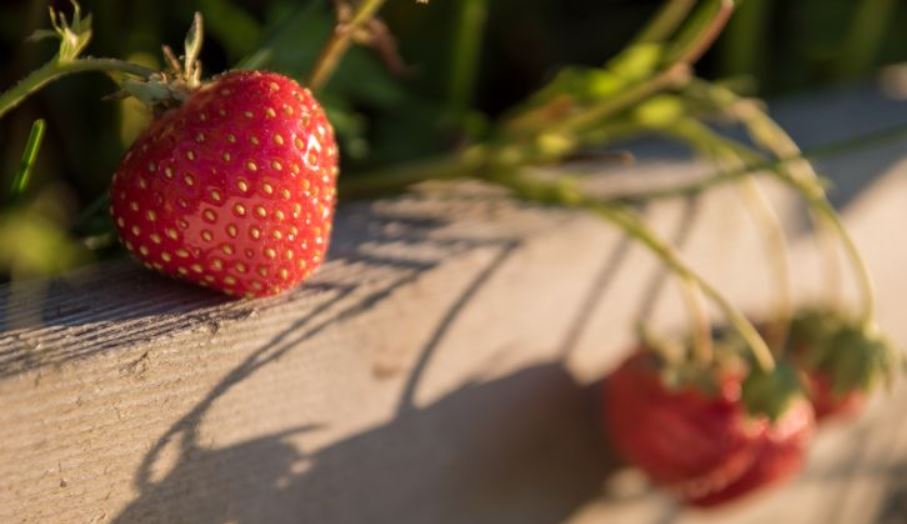
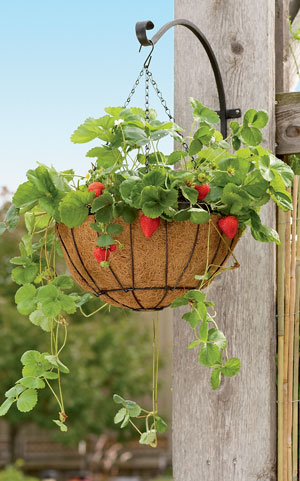 Even a hanging basket can support a small crop of berries.
Even a hanging basket can support a small crop of berries.Berries and other so-called small fruits generally don't require as much space as full-size fruit trees. By growing several different types, you can enjoy home-grown fruit from early summer through late fall.
Keep in mind that the term “small” in small fruits refers to the fruit size, not the size of the plant. In many parts of the country, a full-size, highbush blueberry plant may grow up to 12 feet tall and 6 feet wide. Blackberries can grow 8 feet tall and spread even wider. Growing your backyard berries in raised beds is a good way to keep them manageable.
Seek out varieties that are reliably winter hardy and well-suited to your growing area. Plants should be certified disease-free to avoid the viruses that weaken plants and reduce yields). In most parts of North America, planting berries in early spring is best, whether you've purchased dormant bare-root stock or a plant that's growing in a container.
Before making a purchase, you will also need to determine whether the type and variety of plant is self-fruitful or requires a different plant in order to yield fruit (cross-pollination). Muscadine grapes, kiwis (genus: actinidia) and most blueberries require two compatible varieties for successful pollination. Kiwi plants are also either male or female, so you need to plant at least one of each sex to ensure fruit set.
The ideal site and soil conditions for your backyard berry patch vary depending on the type of fruit you grow. In many cases, these plants aren't fussy and will grow just fine in an average, well-drained garden soil with plenty of sun. That said, there are a few with particular soil requirements, as noted below.
Strawberries
Strawberries are the most popular fruit for the home garden. They're also one of the easiest and most rewarding crops, as long as you choose the right variety and take a little time to understand how the plants grow.
Unlike blueberries, raspberries, currants and others, strawberry plants are short-lived. The original "mother" plants are usually at peak production for just one to three years. During the growing season, mother plants produce a crop of berries as well as three to six offshoots — smaller versions of themselves, called "daughter" plants. To maintain a productive strawberry patch, it"s up to the gardener to manage the balance between mother plants and daughter plants and prevent the bed from becoming too crowded.
When people think about strawberries, they are usually thinking about the summer-bearing varieties that produce one very large crop in early summer (hence their other common name "June-bearers"). The second most popular type is known as "everbearing". These plants produce two smaller crops, the first in the usual June period and the second in late summer/early fall. A relatively new introduction is the "day-neutral" strawberry, which produces fruit throughout the season. If it's abundance you're after, stick with a summer-bearing variety. Learn more about growing strawberries in the Vegetable Encyclopedia.
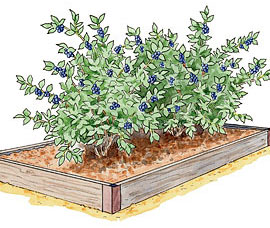 A raised bed works especially well for blueberries. For more information, read Growing Berries in Raised Beds.
A raised bed works especially well for blueberries. For more information, read Growing Berries in Raised Beds.Blueberries and Lingonberries
These members of the genus vaccinium require acid soil (pH 4.5 to 5.5) to grow well. Use a pH tester to find out what your soil is like. If your soil is not that acidic, consider growing in raised beds, where it's easier to control soil pH.
Altering the pH of soil in an existing site is a bigger job: Start by amending the soil a year or so in advance by digging in peat moss, coffee grounds and pine needles. Once the soil pH has been adjusted, you will need to maintain the acidity by using an acidic mulch material such as pine needles.
Too keep your plants productive —whether in-ground or in raised beds— fertilize once or twice a year with a granular organic fertilizer that?s formulated for acid-loving shrubs.
Learn more about growing blueberries in the Vegetable Encyclopedia.
Raspberries and Blackberries
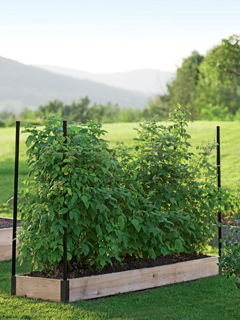 Rasberries benefit from supports that keep the canes upright.
Rasberries benefit from supports that keep the canes upright.Berries in the genus rubus are also known as brambles, and they are among the easiest and most popular of all backyard fruits. They have a network of perennial roots that send up shoots, or canes, which usually live for two years. In the first year of growth, the canes are vegetative, producing only leaves. In the second year the same canes bear flowers and fruit, then die at the end of that season. Because the plants are continuously producing new vegetative canes, once the plants are established you can expect them to yield a crop of fruit every year.
Brambles are vulnerable to viruses and several other diseases. To reduce the risk of infection, avoid planting them on soil where a member of the nightshade family (tomatoes, peppers, potatoes, eggplant) or wild Rubus have recently been grown. For the same reason, it's best to locate raspberries and blackberries at least 500 yards away from any wild brambles.
Raspberries and other cane fruits have shallow root systems, so it's important to remove any weeds, which will compete for nutrients. The most common way of growing raspberries is in rows spaced 6 to 12 feet apart. This generous spacing allows mulching between the beds with weed fabric and wood chips, or cultivating between the rows with a rototiller,. It also ensures good air circulation around the plants (to limit disease problems), and permits easy access for picking from both sides of the bed.
To enjoy bountiful crops of these berries, the plants should be pruned annually and kept weed-free. A well-tended bed of brambles will produce for ten years or more before the original plants start to decline and need to be replaced.
Currants and Gooseberries
These relatively uncommon members of the ribes genus are far more popular in Europe than they are here in the U.S. Red currant jelly is a breakfast staple, and in France, black currants are essential for making the cordial Cassis. Gooseberries are a favorite for pies and are also used in meat dishes.
A single currant or gooseberry plant will produce plenty of fruit for the average household. The plants are not fussy about soil, require little to no pruning and are long-lived. Give them a few shovelfuls of compost each spring and keep them mulched to avoid weed competition. Learn more about growing currants and gooseberries in the Vegetable Encyclopedia.
Print this Article:
Get the Dirt
Stay up to date on new articles and advice. Please fill out the information below.


